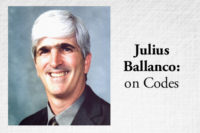The IAPMO Plumbing Technical Committee will meet May 1-2 at Disney Paradise Pier Hotel in Anaheim, Calif., to review the public comments submitted on the proposed plumbing code changes. Then May 3-4, the IAPMO Mechanical Technical Committee will review the mechanical public comments.
There are public comments submitted to 145 plumbing code changes. That amounts to more than 40% of the original changes submitted during the cycle. A number of code changes have multiple public comments.
Many of the public comments are related to updating standards, adding standard references to the code and correlating extracted text from other documents. The new method of referencing standards requires it to be referenced in a code section in order to be a mandatory standard. Otherwise, the standard is simply a referenced standard that an engineer or contractor could use. However, final acceptance of the standard rests with the authority having jurisdiction.
The changes that impact the plumbing and mechanical engineering profession deal in water pipe sizing, drain sizing, venting and storm drainage. One of the major changes developed following research sponsored by IAPMO, ASPE and others involves the sizing of residential water piping systems when low-flow fixtures are used.
In the classroom
Research was conducted at the University of Cincinnati and the study identified a new method for sizing the water piping based on the flow rate and probability of simultaneous use. The sizing method uses Hunter’s concepts and updates the sizing based on a study conducted throughout the U.S.
Having the opportunity to work with the committee that developed this sizing method, I can report the method is impressive. While it is identified for sizing in single and multifamily residential dwelling units, you can easily use the sizing method for any dwelling unit, including high-rise buildings.
The interesting part of this change is it references a spreadsheet for sizing. You have to download the spreadsheet to size a piping system. I would encourage every plumbing and mechanical engineer to download the spreadsheet and see how it works. It is available at no cost at https://tinyurl.com/kxcevr7. The research paper also is available on the website.
This new method will be an option for sizing. The code currently permits accepted engineering design. This would simply be another accepted engineering design.
One of the hot issues in drainage pipe sizing is the minimum size for a shower drain. There are numerous comments submitted to lower the shower drain trap size from 2 in. to 1 1/2 in. This proposed change originally was rejected even though the technical support for the sizing was not challenged. Shower drain size has been a hot issue at IAPMO Plumbing Technical Committee meetings for the last number of years. It is an area where everyone gets hung up on having a 2-in. drain. Even though there are many comments, it is doubtful the change will be accepted.
Confusing times
Another drain code change deals with the distance from trap to vent. The public comment modifies the original change by inserting pitch values for determining how far a trap can be from a vent. The proposal is based on work done at the National Bureau of Standards more than 50 years ago.
There are two venting changes with public comments. One deals with the roof vent termination; the other is the acceptance of air-admittance valves. One of the comments proposed to require the acceptance of air-admittance valves and would call for a leak indicator and a dual failsafe, such as a second sealing member. The proposal also would require annual testing of the air-admittance valves. I read this public comment a number of times and I am still confused as to what the proponent of the comment wants.
The other public comment on air-admittance valves would move the requirements to the engineered plumbing design section. This would require a registered design professional to design the system using air-admittance valves. The code already permits air-admittance valves under the engineered design, however no guidance is provided to the AHJ regarding the design of the system.
Under storm drainage, there are three issues that all received multiple public comments. The first issue relates to a combined primary and secondary roof drain. The proposed change would require separate and independent strainers for the primary and secondary roof drains.
Currently, the building code would not consider the secondary roof drain an emergency drain if it was under the same strainer as the primary roof drain. The Building Code requires structural loading to be based on the primary drainage means becoming blocked. The blockage applies to the strainer since this is the most common location for a stoppage of the primary roof drain. If the strainer is blocked for the primary, it also is blocked for the secondary.
While you could use the single strainer combined primary and secondary roof drain, you would have to provide structural loading for water ponding to the top of the parapet. Hence, it defeats the purpose of providing a secondary roof drain.
Another change proposes to include the ASPE/IAPMO standard for determining the flow rate through a roof drain. This consensus standard has been opposed by many of the major roof drain manufacturers. This standard was reviewed in last month’s column on sizing storm (roof) drainage systems.
Finally, the last storm drainage code change would add the sizing method identified in the ASPE Research Foundation report on roof drainage. The sizing method would require a systems approach as opposed to assuming the pipe will flow so much rainwater when a major storm occurs. Again, the major roof drain manufacturers are opposed to this sizing method, even though they recognize the current sizing method is incorrect.
It is amazing that the major manufacturers support the highly-engineered design of a siphonic roof drainage system, yet they are against any engineering being used to design a standard roof drainage system. There should be some wild discussions on the subject matter again.
You can download all of the public comments on the IAPMO website. The monograph offers interesting reading and it provides insight as to the reason for a given code requirement.
This article was originally titled “Time to debate” in the April 2017 print edition of PM Engineer.



